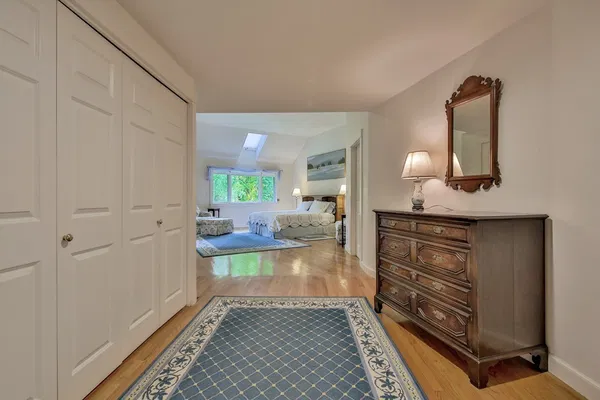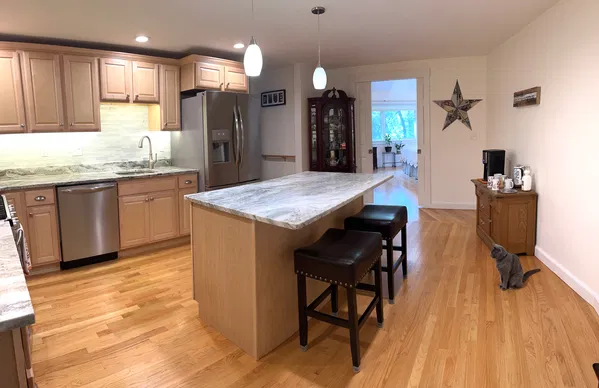
Have you ever thought of creating an additional or separate living space within your own home, or on your property–for your parents or extended family? We spent a few years conceptualizing how we could make a multi-generational living arrangement work for our family, exploring adding on to our own house, buying an existing house and adding on to that, even building a new house–we talked with various towns about their zoning bylaws, and we finally hit the jackpot when we found a large home with enough square footage to partition a private space for a first floor in-law apartment. At the time we had three teenagers and 2 dogs, and were looking to join households with my mother and step-father. My step-father had Parkinson’s disease and we knew there was a short amount of time remaining where he could live independently and still maintain their property without a fair amount of help from family members or having to hire out for many services.
We could plan to mow their lawn on the weekends, but we couldn’t live in Westminster and get someone over to their house in Templeton whenever there was an overnight snowstorm. They had a great neighbor who helped a lot, but it wasn’t sustainable, and they just weren’t best served living in a large house, with a drive under garage which required stairs no matter which door you used, to get the main level.
We had a big advantage in that my mother and step-father already had a house that had an accessory apartment. So, when we approached them to see if they might be interested in joining forces, the easiest answer would have been for them to move to their accessory apartment, and we would move in to the larger side of their house. There were a few issues with that concept. Foremost was that our kids were pretty entrenched in their schools, and I drive so much that being in Templeton would have had me away from home a lot more than I wanted to be.
We spent a year trying to figure a way to add onto our existing home. We got approval through the Westminster zoning board to add an accessory apartment to our 1790 brick house. We had plans designed and got estimates from three builders. Unfortunately, we designed what we wanted, which resulted in a bit of sticker shock upon receiving estimates. We decided if we were going to take the equity we had in the house and add money to it, we had to be smart about it, so that we didn’t create a unicorn of a house that no one would ever want on the resale. And more importantly, that we would never get back our investment in.
This was in 2014, the real estate market was pretty moderate, and although we had spent money on plans for an addition, we decided to sell and move temporarily to my parents’ house in Templeton. Even as a temporary solution, this resulted in so much more driving for Jay, getting the kids to schools in Ashburnham and Princeton.
While living in Templeton for over two years, we looked at every single potential home that came on the market in Westminster. Did it have an in-law? Could we add an in-law? What was the bedroom count related to the septic system size? I even knocked on a few doors of houses that might be potentials.
We weren’t finding anything, so our minds turned to building a new house. Land was somewhat available, we found a plans designer we were happy with, and between my mother and I, we made a very nice house, on paper. A Kitchen and 2.5 Baths on our side, a Kitchen and 1.5 Baths in the apartment = 2 Kitchens and 5 Baths. Remember this was 2014, before prices even went crazy. I met with a builder (I didn’t have a builder client at the time) and he stared at the plan for just a few minutes, and said… “Very nice. Very very nice. $700,000. Where is your land?” Since I didn’t have land, or land plus $700,000 +site work, +utilities, +septic system, +well, +driveway, +etc., we decided to increase the list of towns we were open to, looking for an existing XL house that we could get creative with. Because years had passed at this point, one kid had gone off to college, another was at Monty Tech (opening us up to 20 towns), and our youngest had her sights on playing tennis at Wachusett, we opened up our search to the 5 Wachusett Regional School District towns.
Still, it was a bit of a needle in a haystack. In addition to being specific about towns, we also knew that we wanted a house that had the ability to have two full Kitchens. Also, my parents couldn’t be in a basement or above a garage–we really needed to avoid steps.
The story of how we ended up here is the opposite of how I would think my home purchase would have gone. I was working at an open house in Westminster. Jay called me and asked me what I was doing. I said “I’m at an open house, where are you?” He said “I’m at an open house, with Erin (our youngest). Erin told me you said we weren’t going to even consider this house”. I said “OH, that house. 🙁 We aren’t buying THAT house. It’s too big, it’s too expensive, and it doesn’t sing to me”. After more than two years living in semi-temporary housing with all of our things in storage, Jay, losing his patience with my selectivity, said “Well, it’s singing to me, and you better get over here.”
Although I was admittedly resistant to buying the house we’ve now lived in for more than 6 years, it really was the perfect spot to create our multi-generational living situation–I just couldn’t see it at the time. In hindsight, it was the best personal decision, and best investment decision, I’ve ever made.

Before: This was a large first floor bedroom addition with sitting area that the sellers built about 10 years before we bought our home. There was a laundry, large closet and a full set of stairs to the basement behind those bi-fold doors.

After: We pushed the left wall back about 8 feet, losing the laundry, as well as the large closet and full set of stairs to the basement, and gaining space to include a full sized kitchen. We added recessed and pendant lighting and chose a cabinet finish that aligns with our primary kitchen, which is only about 15 feet away. We also put a wall with a double pocket door (separating the main area from the bedroom) so that the space can be wide open, or closed for privacy. The bedroom includes a bathroom and a very large closet with a stackable laundry setup. My mother calls it Oprah’s closet. To the right of the refrigerator is the living room, which connects to our living room (via a glass door) on the other end. By using the previous first floor bedroom space and apportioning a living room to the accessory apartment, we were able to create a totally separate living area–with over 1,200 square feet.
When I list a property for sale, I’m happy to include the combination of professional photos, video, and floor plans–because I really needed all three to come to the conclusion that this would be the perfect house for our situation. In our case, when considering this house, I stared at the floor plans, wandered through the house on the video, and patched together photos to determine how we could turn this large single-family home into living space for multiple generations.
We found Princeton to be quite friendly toward our idea of constructing an accessory apartment within our home, and the town also allows for detached accessory apartments, where not all towns allow that.
Princeton’s definition of Accessory Apartment: A dwelling unit subordinate in size and accessory to an owner-occupied, detached single-family dwelling. The apartment may be located within the single-family dwelling or in a building accessory thereto, such an attached or detached garage or barn.
The purposes of the Accessory Apartment bylaw are to provide small dwelling units to rent without adding to the number of buildings in the Town or substantially altering the appearance of the Town; to provide alternative housing options; and to enable owners of detached single-family dwellings larger than required for their present needs to share space and the burdens of homeownership.
The accessory apartment shall be located within a single-family dwelling or in an accessory structure on the same lot, such as an attached garage or a detached garage or barn, and shall clearly be a subordinate part of the building. –Town of Princeton website
I’ve provided links below to information about accessory apartment bylaws for several Central Mass towns. There’s a pretty consistent theme related to safety, adequate utilities and exterior appearance, with each town having their own very specific guidelines, requirements and process.
When we were looking for a house in Princeton, we judged all potentials based on the town’s criteria for allowing an accessory apartment. After several near-misses, we found a house that didn’t need an addition–we could just carve out space from the first floor of the existing structure. Adding on would have been an option, but if we were to do that, there are conditions related to that. From an exterior perspective, the home must maintain the look of a single family home, have two means of egress from the accessory apartment, and have a minimum of one additional off street parking spot.
Further, we had to make sure that the septic system was sized for the actual bedroom count. Our project involved taking space from a huge first floor master bedroom suite and living room, so we didn’t have to worry about septic system modifications because we didn’t change the bedroom count. If you’re considering buying a house that you’ll add on to, you should look for either a home served by town sewer, or a three bedroom house with a four bedroom septic system.
Princeton’s bylaws limit an accessory apartment to be no more than 900 square feet or ⅓ of the living area of the dwelling. We knew that this would be a tough one for us to meet the maximum of 900 square feet, since my parents wanted about 1,200 square feet, but the town also allows for the apartment to be up to ⅓ the size of the dwelling, so we were allowed to up-size our apartment.
We hired a plans designer to create a space that would give everyone privacy, would have a good layout flow, and be consistent with the finishes of the main part of the house. We eliminated a secondary set of stairs to the basement, which gave us enough space for a full Kitchen. We provided the plans to the Planning Board, had our hearing, got our approval, obtained a building permit, and set off to create our one bedroom accessory apartment.
At the time of our home conversion, white cabinets were all the rage, but we wanted the apartment to not be completely different from the main part of the house, since my mother’s Kitchen and the main Kitchen are only about 20 feet away from each other. We selected a light wood finish cabinet to match our Kitchen, and then made timeless hardware selections for both Kitchens, everybody got stainless appliances, and we converted our electric stove to propane.
When you’re thinking about merging households with your parents, inlaws, etc. there are many things to consider. A good exercise is to meet with your trusted attorney or an elder/estate attorney. I’m happy to recommend a few for your consideration.
Family dynamics
Our youngest was 11 when we merged households, so we didn’t have to talk about parenting small children. However, we had teenagers, which is a whole different type of parenting, and something to consider discussing ahead of time. How your parents raised you is very different from the parent/teen dynamic of the post-Covid era.
Who will pay for the property?
If you’re buying a new home with a conventional loan, it’s likely that you can receive a gift to contribute to the initial purchase price of the home. Talk with your lender about that. If anyone else is contributing financially to the project, make sure the expectations are clearly written out ahead of time to avoid misunderstandings, hard feelings and even fractured relationships.
Who will own the property?
Will you and your spouse own the property, or will the inlaws be on the deed, mortgage? What are the positives, negatives and risks of the various scenarios?
Will you share expenses, collect rent?
It’s my understanding that options are to either collect rent (which means you’ve then got to report it as income) or to be aware that any money from your in-laws counts as a gift for taxation and estate purposes.
Who pays for repairs and improvements?
Here are a few real scenarios we’ve had come across our checkbook lately, and the answers on who pays for them comes easily for us because we discussed A LOT up front.
–We recently spent $1,800 to rid our home of bats, and $1,300 on carpenter bees.
–My parents wanted an A/C mini-split and a lot of handrails installed.
–We needed to have a railing and gate built that would separate our deck areas because Pugsley liked to go over on their side of the deck and do his business.
–We had several large trees taken down that were dead or declining and posing a risk to the in-law side of the house.
–We’re considering getting a whole house generator so that, among other things, our septic pump and well will run during power outages.
You can see that there’s a mix of necessary, optional and gray areas in the list above. We don’t really talk about these items on an individual basis, because we had those discussions ahead of time.
What if anyone needs nursing home care?
If there are age or health concerns, you should be aware of the Medicaid five year look-back period. Scenario: Imagine if your parents split the purchase of a home with you, and then one of them needs to go in a nursing home and doesn’t have the income and assets to pay for the nursing home (~$15,000/month). If it’s been less than 5 years since they gifted you money to buy in to the house, this could become a problem in that money might need to be brought back in to play to pay for the nursing home before Medicaid would pay their expenses.
What happens if anyone in your equation dies?
Your attorney can help craft a plan to make sure that the original intentions of all involved are taken in to account, and the property is affordable to you if you were relying on any financial assistance from others living in the house.
What if you sell the property?
What are the expectations of the people who contributed to the purchase of the property? If you buy a house in a slow real estate market, and receive gift income to do so, then 5 years later you sell in a higher real estate market? Do the in-laws get back what they put in, or are the proceeds divided based on a percentage of the initial investment? Can any parties force a sale?
Ouch, living with the in-laws isn’t always easy. What if you get divorced?
I’m sure that won’t happen, but you really should openly discuss with your partner, parents and attorney to come up with a formal agreement to address any intentions at the time of the purchase.
There are very important questions to discuss up front. Although you can’t think of everything, there are some things your attorney can help facilitate a discussion around.
Expectations, Tolerance and Common Courtesy
Overall, I think the most important thing is to go in to all discussions knowing there will have to be compromise and likely everyone will need to adapt in some way. Once the administrative and financial structure of your new living arrangement is agreed to in principle, talk through general housekeeping items – house rules, respect for personal space, etc.
I’ve included below links to start researching accessory apartment bylaws in your town, or towns you’re considering for a potential multi-generational living situation. I’m happy to discuss how we’ve made it work, brainstorm with you on a potential conversion of a property you already own, your potential purchase or just talk things over with you. I’m very happy we went through this process, even though I’d probably skip a few steps that we spent money on, but we had to go through the exercise to determine the best end result for us, so I don’t think I’d change a thing.

How to get started on your research in some local cities and towns
Ashburnham
Ashburnham Town Website
Ashburnham Planning Board
ADU Rules and Regulations
Ashby
Ashby Town Website
Ashby Planning Board
Ashby Permitting Guidebook
Ashby Zoning Board of Appeals Guide
Boylston
Boylston Town Website
Boylston Planning Board
Boylston Zoning Bylaws
Clinton
Clinton Town Website
Clinton Planning Board
Clinton Zoning Bylaws
Fitchburg
Fitchburg City Website
ADU Information (draft zoning amendment)
Gardner
Gardner City Website
Gardner Planning Board
Gardner Zoning
Holden
Holden Town Website
Holden Planning Board
Holden Zoning Board
Hubbardston
Hubbardston Town Website
Hubbardston Planning Board
Hubbardston Zoning Board
Hubbardston proposed changes to Accessory Dwelling Units
Lancaster
Lancaster Town Website
Lancaster Planning Board
Lancaster Zoning Bylaws
Leominster
Leominster City Website
Leominster Planning Board
Leominster Zoning Ordinance
Lunenburg
Lunenburg Town Website
Lunenburg Planning Board
Lunenburg Zoning Bylaws
Paxton
Paxton Town Website
Paxton Planning Board
Paxton Zoning Bylaws
Princeton
Princeton Town Website
Princeton Planning Board
Princeton Zoning Bylaws
Princeton Special Residential Use Regulations
Rutland
Rutland Town Website
Rutland Planning Board
Rutland Zoning Bylaws
ADU Bylaw proposal
Sterling
Sterling Town Website
Sterling Planning Board
Sterling Zoning
Templeton
Templeton Town Website
Templeton Planning Board
Templeton Zoning Board
Templeton Definitions
Templeton Use Districts
Westminster
Westminster Town Website
Westminster Planning Board
Westminster Zoning Board
Westminster Zoning Bylaws
Westminster Accessory Dwelling draft
Westminster Table of Uses updates
West Boylston
West Boylston Town Website
West Boylston Planning Board
West Boylston Zoning Board
West Boylston Zoning Bylaws
West Boylston Order of Events for Accessory Apartment Special Permit
West Boylston Accessory Apartment Special Permit Application
Winchendon
Winchendon Town Website
Winchendon Planning Board
Winchendon Zoning Board
Winchendon Zoning Bylaws



